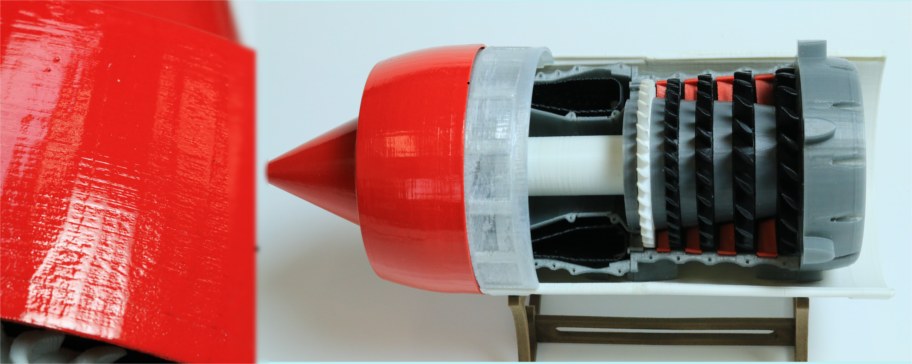
High Impact Polystyrene (english, abbreviated HIPS HIPS) is a modified high impact polystyrene by rubber. The thermoplastic plastic is particularly used for cases of, for example, computers, TV sets or telephones. Inside of refrigerators, the first, very cold-resistant layer is often made of HIPS. The plastic is used in plastic toys.
Another application of HIPS is used in 3D printers as washable substrate.
A special feature, in addition to the extreme cold resistance, is the property of the antibacterial effect on the surface.
HIPS prints especially even and in detail and is in feel and look of all FDM materials closest to injection-molded parts.
For very large and flat parts can lead to warping.
Advantages
Disadvantages
HIPS is always used when a particularly impact-resistant and abrasion-resistant plastic is needed.
By atypical for FDM high optical surface quality of this material is also often used for the production of objects or intuition as a prototype.
A common use is the production of spare parts such as gears or installation pattern.
HIPS is moulded in the so-called FDM.
FDM means literally 'Fused Deposition Modeling ".
FDM is one of the simpler procedures of 3D printing. Manufactured components have
visible Layer (coatings) on. The advantage of this technology is the pressure in a
high variation of materials and the direct use of technical
plastics. The material is genuinely applied and thus differs
most other procedures, with materials having approximate properties
work. Another advantage is the possibility of closed cavities.
FDM is not suitable for small parts, because they overheat.
The procedure:
The model is broken down into layers of 0.1 0.2 mm.
Now, a plastic wire is forced through a hot nozzle and into a viscous
State puts. A CNC-controlled print head now moves from the contour of the component
and while applying the desired layer thickness.
Washable support structures of alcohol prevent hanging of overhangs.

Shipping within
8 Working days
Minimum wall thickness
1 mm
Smallest Detail
0.3 mm
Maximum dimension
ø 170 mm x 285 mm
When ordering before 12 am We will ship within 2 Working days. �
Price
30 % extra charge
The surface of your model is determined by the technology and the chosen material. Therefore, we offer several post-processing steps. This affects the cost but also the quality of your model.
The natural surface of HIPS is perfect if you want your model just as functional or demonstration prototype. So you'll be able to see the material and method using the surface as we do nothing more than to print your part to remove the insulatorss and ship it to you.
Available colors:
White
Polished models in HIPS have no high-gloss surface. They have a slightly rough but very smooth surface.
All parts are sanded by hand and then sandblasted. For this reason, it may be that your part is subsequently rejected if it is not to edit by hand.
What is to be observed on polished models:

Of course, you can also paint models from 3D HIPS .
Here, the quality and RAL color can be selected. The basic version of the painting is a simple "spray paint".
This means that is your part lightly sanded and then painted. Construction stages and the similar are still easily recognizable.
The highest quality is the quality in premium (car paint). This "Polishing" must be booked with.
Your part is sanded, polished, filled, wet sanded and painted.

HIPS parts can also be wonderfully coated.
To do this, your model is ground and then coated with your desired equipment. Here, also, a coat with gold or silver is possible.
| Copper | 99,99% Cu | IMDS Nr. 736943 |
| Matt nickel, from Sulfamatelektrolyt | 99,95% Ni | IMDS Nr. 748706 |
| High-gloss nickel | >99,50% Ni | IMDS Nr. 749088 |
| Gold plating 24ct. | 24 Karrat Au | IMDS Nr. 756617 |
| Silver plating | 99,99% Ag | IMDS Nr. 757803 |
| Chrome plating | from the trivalent electrolyte, RoHS Compliant | IMDS Nr. 756617 |
| Black chrome plating | electrically conductive, Black Chrome coating | IMDS Nr. 10629626/1 |
| Electroless Nickel Plating | hochphosphorig, 13% Phosphor as NiP | IMDS Nr. 326271538 |
| Tin plating | 99.98% Sn, RoHS-Konform | |
| Bismut | our Bismudan� electrolyte, 99,95% Bi |
| Unit | Value | ||
|---|---|---|---|
| Tensile strength | MPa | 34,5 | |
| Elongation at break | % | 30 | |
| Hardness | HR | L60 | |
| Thermal resistance | �C | 83 | |
| Impact resistance | kJ/m� | 5,88 | |
| Density | g/cm� | 1,07 | |
| Water absorption | % | 0,6 | |
| Chemical resistance | n/a | ||
| Weather | Resistant | ||